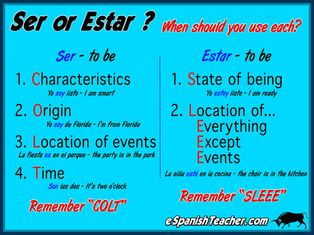 Perhaps one of the most common questions for Spanish teachers from their students is how to determine when to use Ser and when to use Estar. Because both verbs mean "to be", it can be a very difficult concept to fully understand. I've created the graphic below to help you understand the difference between ser and estar and when to use each verb. I dive into this topic in more detail in my Beginner Spanish course. Let me know what you think of this graphic. I've started using more visuals like this to teach Spanish and have been getting very good feedback. Spanish verb conjugation is perhaps the most crucial concept for beginner students. So much of what new students learn centers on understanding how to conjugate Spanish verbs. This is because verbs and subjects are the foundational elements of sentence structure and therefore are the foundation of virtually everything you say in Spanish. It’s no different for English—by the way—we just don’t often realize it.
Subject Pronouns or Subjects In Spanish, conjugating verbs is simple, but it does require some explanation as well as a good deal of verbal practice before you’ll understand it completely. Conjugating verbs always begins with the subject of the sentence because we need to know who is acting out the verb. You may hear your Spanish professor refer to subjects as 'subject pronouns', but I think that term confuses people. In my simple mind, they are subjects and it doesn't need to be any more complicated than that. So the subject is the noun (person, place, or thing) that is doing the verb (action word). Common subject are I, you, he, she, it, we, they, etc. Spanish Verbs Verbs are the action word of a sentence, such as run, eat, play, speak, etc. Usually verbs are simple to imagine in your mind. For example, it’s easy to imagine someone running, eating, playing, and speaking. These would all be examples of verbs in their infinitive (pure) form: to run, to eat, to play, to speak. Spanish Verb Conjugation Conjugating verbs requires that you match a subject with a verb. And the most important thing to remember is that the subject determines how the verb is conjugated. When you conjugate a verb, you remove the to and replace it with a subject. In other words, you actually change the verb from its infinitive form (to eat) to a conjugated form when matching it up with a subject. You also sometime change the ending of the verb slightly, such that He + to eat becomes He eats. Or She + to run becomes She runs. This is the essence of verb conjugation, which is the foundation of the Spanish language. It may seem simple in English, but conjugating in Spanish actually presents a couple more challenges because 1) it’s not your native language and 2) the conjugations are much more complex than simply adding an “s” to the end of each verb. This is a quick blog post meant to help you understand the basics of conjugating verbs in Spanish. For a more in-depth look at this topic, as well as a more personalized explaination, verbal exercises, and instant feedback, check out my Beginner Spanish course.In Spanish, a simple example would look like this: Subject: Ella = she Verb: Comer = to eat Ella + Comer = Ella come = She eats To accomplish the example conjugation above, these are the steps we take: 1) Identify the subject 2) Drop the “-er” ending from the verb Comer. 3) While adding the subject, conjugate the verb Comer according to the subject. You can use this subject chart to identify which ending corresponds to which subject. Also, I've included a chart on conjugating verbs in the present tense for reference. Is it hard to learn Spanish?
As a Spanish teacher I get asked this question very often. How difficult is it to learn Spanish? The answer may surprise you. In short, it depends on a number of factors, but usually isn’t too difficult. Let me explain. The first question you need to answer is why are you learning Spanish and how proficient would you like to become. This is important because if you are learning Spanish for a job in a professional environment, then it’s likely that you’ll need to be nearly fluent in order to excel at that job. However, if you want to learn Spanish so you can speak to your neighbors and your goal is not to be completely fluent, then conversational Spanish proficiency is all you’ll need. Do I need to be fluent in Spanish? Speaking Spanish fluently means that you could go into a doctor’s office and describe most of your body parts in Spanish. It means that you could attend an institution of higher learning, comprehend perfectly the materials that your professors would teach, and write pages on specialized topics in Spanish. But most of us don’t wish to become that skilled in the Spanish language. And despite the claims of many Spanish language products and courses, becoming fluent in Spanish would likely take years of living in a Spanish speaking country and rarely speaking English. More on conversational Spanish Conversational Spanish is not difficult to master. Even the poorest classroom students are able to learn to speak in casual conversations with native Spanish speakers. In fact, many who don’t perform well in traditional classroom settings do extremely well learning languages. This is because learning a second language is similar to memorizing the words to your favorite song. Think about the last time a great song came on the radio. You hear it a few times and before you know it you could sing the lyrics from memory without any help from the band. You may have noticed that each day we hear, see, and use Spanish words, phrases, and popular catch phrases. Chances are you already know a good amount of Spanish. Here are some of the popular phrases used in today’s culture: Adiós = Goodbye Pronto = Hurry up Por favor = Please Grácias = Thank you Si, se puede = Yes we can/Yes you can De nada = Don’t mention it Mi casa es su casa = Please feel at home ¿Cómo estás? = How are you? Buenos días = Good day Hasta la vista = See you next time Mano a mano = Man to man Se habla español = We speak Spanish Learning to speak Spanish is not difficult and becoming conversant in the Spanish language is something that the average person can accomplish. The key is to have a few great resources that can explain the rules of the language, such as grammar books, a Spanish-to-English dictionary, and a friend who speaks Spanish. This way you’ll be able to overcome some of the confusing concepts that surface from time to time. Lastly, make sure you get a good amount of verbal Spanish practice, perhaps through watching the Spanish channel on TV and repeating what you hear, listening to Spanish radio, watching movies in Spanish, or having actual conversations with people who know how to speak Spanish. 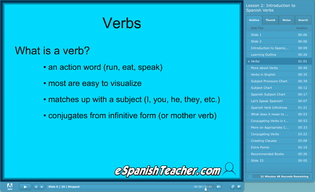 This blog post is kicking off my new series on the most common Spanish verbs. These posts will contain useful and relevant help to all of you out there who are beginning to speak Spanish. Please let me know if there are verbs you'd like me to review. In Spanish verbs end in -AR, -ER, or -IR. Remember that verbs are action words. I have a unique perspective on Spanish verbs that I explain in depth in my Spanish course. I believe there are two types of verbs, simple and vague. First, the simple verbs are easy to imagine or visualize in your mind. It's easy to picture someone running, eating, or talking. And sure enough, to run, to eat, and to talk are all verbs. These are examples of the simple verbs and include nearly all verbs. The second group is what I refer to as vague Spanish verbs, or the verbs that are more difficult to imagine. Unfortunately, these are the most common verbs that are used multiple times in nearly every string of communication, such as to be, to have, to exist, and to be able to. The mastery of verbs--both simple and vague--comes with listening, practice, and confidence. For this post, I thought I'd address one of my favorite verbs, tener. Tener means 'to have' in Spanish, and you can use it to say things like "I have a meeting", or "You have to go", or "She has a pet cat". Here is a breakdown of the verb tener in the present tense: Yo tengo - I have Tú tienes - you have (informal) Ella tiene - she has Él tiene - he has Usted tiene - you have (formal) Nosotros tenemos - we have Vosotros tenéis - you guys have (informal) Ellos tienen - they have Ellas tienen - they have (group of females) Ustedes tienen - you all have (formal) Some examples of phrases using tener: Yo tengo un amigo - I have a friend Nosotros tenemos que ir - We have to go Ella tiene una cita - She has an appointment Tener is perhaps one of the top 3 verbs used in the Spanish language, so get used to it, memorize it, and start loving it! I speak with a lot of people who want to speak Spanish, most of whom ask questions about the language and wanting my recommendations for an effective Spanish course. It’s common for these people to be curious about how difficult it is to learn Spanish. They aren’t asking how difficult it is to learn the language in full. What they really want to know is ‘how long will it take me to learn enough Spanish to feel comfortable getting around in a foreign country or in a light conversation with a native Spanish speaker?’
How long it takes you to learn conversational Spanish depends on you. Are you someone who can recognize patterns, enjoys music, and understands basic math? If you said yes, then your chances of learning Spanish quickly are very good. Having an appreciation for patterns, music, and math are important because they help you understand the building blocks of the Spanish language—Verbs. Spanish Verbs, along with subjects, are some of the most basic elements of the Spanish language and having a clear understanding of them will help you speak Spanish more than any other concept. And once you understand the relationship between subjects and verbs, you ability to speak and grasp the more advanced concepts greatly improves. When setting out on their journey to learn Spanish, many students ask ‘where do I begin?’ Formal Spanish language courses taught by your community college or in a textbook will start by teaching you how to say things like ‘the’, ‘a’, and ‘and’. Then you’ll advance to—dare I say—nouns! By the end of week one you’ll be saying things like, ‘the dog’, ‘the food’, and ‘the house’. My Beginner Spanish course takes a different approach, however. The first four lessons of Beginner Spanish aim to solidify the student’s ability to match a subject with a verb and then create a basic sentence. After just an hour you’ll be saying things like ‘I eat the cookie’ and ‘we watch the movie.’ Shortly thereafter you’ll be able to ask and answer questions in complete sentences. This type of verb-based learning has two benefits. First, it puts a lot of Spanish words into your vocabulary very quickly so as to prepare you for actual conversations you might have. Second, it establishes a foundation in your brain that helps you understand all the subsequent Spanish language concepts that you will learn. Learning Spanish as a second language will help you understand English better. The reason for this is that both English and Spanish have rules that come from latin origins and it's easy to use your understanding of English to support your Spanish language study as well as using Spanish to reinforce your understanding of English.
As you begin to familiarize yourself with the structure of the Spanish language—namely subjects, verbs, and object—you’ll start to see how the various parts of speech all come together to create a coherent message. You'll start to see how communication between two people is not just a string of random thoughts, rather a structure of organized word combinations. As you do this in Spanish, your understanding of the English language will increase. You’ll start to see how adjectives must agree in number with the nouns they modify and you’ll notice how verbs are conjugated differently with each subject. If none of this makes sense to you, don't worry because you aren't required to know it in order to speak Spanish properly. Your increased understanding of both languages is actually a result of you speaking Spanish, not a requirement. In the end, this knowledge will reinforce your understanding of both languages and make you a better Spanish student. Not only that, you’ll be better equipped to understand the more complex parts of the language, such as the Spanish subjunctive, that are crucial in order to speak Spanish fluently. How can I better understand the Imperfect vs. Preterite verb forms in Spanish? This is perhaps the most common question I get as a Spanish teacher. Let me take some time to clear up the confusion and help establish the meaning and uses of the two. Think about preterite as the simplest form of the past tense, such as "We ate lunch" or "she repaired the door". The emphasis in these two statements is that the verb (the action) occurred in the past, it happened relatively quickly, and now it's over. In fact, many times you will use the preterite verb tense when you want to emphasize that your action is over or not happening anymore. If you were to imagine a timeline with a single dot for the present, actions that happen in the preterite would be a similar dot on a timeline, but in the past (to the left of the present). Ok, now that we have established that the preterite is a single instance (a single dot) that took place in the past, lets now look at the imperfect. Instead of a single dot on a timeline, the imperfect is best represented by a span of time in the past. So it looks more like a mini timeline that happens in the past. If that's confusing, think back to our timeline and the dot that represents the present. To the left of that dot is the past. As opposed to a dot like we used for the preterite, the imperfect is best represented by a shorter line that represents a span of time in the past. People often use the imperfect when relating an event that happened in the past. Two examples are "We were eating..." or "She was repairing the door..." Both examples are happening in the past, but they are part of an event that lasts longer than a single instant. When you use the imperfect, you're not necessarily trying to emphasize that the action is already complete like you are when you use the preterite. With the preterite, the action is complete, it's over, and you are emphasizing the fact that it's finished. "We ate lunch" or "She repaired the door". Here is one final example that uses both forms that may help you understand: "We were eating lunch when suddenly the bell rang." We were eating = Imperfect the bell rang = Preterite Notice that this sentence is actually telling a story (or an event). First, you set up the story by saying "we were eating lunch". This is a perfect example of the imperfect. Then you finish the story with "the bell rang". The bell ringing is a perfect example of the preterite because it happened and now it's over. One more: "She was watching TV when the man screamed." "she was watching" = imperfect (setting up the story or event) "the man screamed" = preterite (it happened and now it's over) Before I go, there is one more use of the imperfect that you should know. If you ever did anything with regularity, that would be imperfect. I call this the "used to..." rule. For example, "I 'used to' run 3 miles every day". or "We would eat dinner together every night". Again you are telling a story of an event that happened with regularity over a length of time, but still in the past. What's the difference between por and para? This is another common question you'll likely have when learning to speak Spanish. In Spanish, in order to say "to" or "for", you would need to use the words "por" or "para". These words can be confusing so it's important to learn the definition and translation of each. Let's take a look:
Por - through, by, for, to, by way of, by means of examples: Vamos por coche. = Let's go by car. Gracias por la ayuda. = Thanks for the help. Para - to, for, in order to examples: Este regalo es para usted. = This gift is for you. Para hacerlo con éxito, hay que practicar. = In order to do it successfully, you must practice. Here is a great chart to help you visualize the difference between Por and Para: There are a lot of options for consumers looking to learn a second language. I get asked about Rosetta Stone quite a bit. And although Rosetta Stone is very popular and has benefits, there are a few things you should understand before making such a large financial commitment to one product that may or may not work for you. Here are the top five reasons I do not recommend the software:
#5 Word associations don’t work We’re all familiar with flash cards, right? You show me a photograph of a cat and I tell you that cat in Spanish is “el gato”. A major part of Rosetta Stone’s curriculum is to flash images in front of the student and the student must remember how to translate the name of that image into Spanish. For example, the student may see a photograph of a cat under a table and should be able to recall that "cat under the table" translates to “el gato está abajo de la mesa.” In my experience, the effectiveness of flash cards/word associations decreases dramatically as you increase in speaking ability and comprehension skills. The exercises can be effective for helping beginner students progress to a point and improve their Spanish pronunciation, but it doesn’t offer the rich and refined language learning experience that is needed to develop useful speaking skills. The Rosetta Stone curriculum relies so heavily on these word associations that many students become frustrated as they advance through the software. #4 Learn like you learned how to speak your first language Years ago I would hear the Rosetta Stone radio ads claiming that they would teach you to learn a second language the same way you learned your first language. There are some major flaws with that methodology and frankly it just doesn’t work. I hope they move away from this claim as it is entirely misleading. After about 7 years, human brains begin to lose the ability to learn the way we did when we were babies. Think about it. Notwithstanding all the laughing, cooing, and crying, a newborn child doesn’t know how to control the muscles in his mouth to form words, sentences, and ideas. This is learned over time as the baby watches his parents, mimics their mouth movement, and copies the sounds coming out of their throats. A lot of trial and error occur as baby attempts to form words for many years before he is ever able to speak a complete idea. Most adults wanting to learn Spanish as a second language simply cannot learn this way. It’s just not practical as we don’t have time to spend 100% of our day in full Spanish immersion. Even for those who work with Spanish speakers or who listen to Spanish all day, they’d still need a healthy amount of grammar rules and language structure explained in order to have success learning to speak. When we reach adolescence, our brains begin wanting a bit more structure and clarity. I’ve found that adult brains really like step-by-step instructions, logic processes, and formulas when learning to speak Spanish. #3 Rosetta Stone is too expensive Rosetta Stone’s level 1 Spanish course is $179. That is too much to pay, especially for those who are testing the waters when it comes to learning a second language. A much better approach for a student new to the language would be to find an inexpensive course that provides effective curriculum that has been proven successful. #2 Shareholders First, I love businesses. Especially those that employ people, create great products & services, and serve to advance our society. That said, businesses and shareholders have a fiscal responsibility to increase shareholder wealth and increase the company's stock price. Sometimes a higher stock price is achieved with product improvements, breaking into new markets, lowering costs, etc. But in today's age of fierce competition and race to increase market share, frequently companies will take shortcuts to riches. If you take a close look at the curriculum and exercises contained in the Rosetta Stone language courses, you’ll immediately notice similarities between them. And while it may make sense to replicate a proven model for teaching Latin-based languages that are similar, it certainly doesn’t make sense to apply that same model to Mandarin, Japanese, Finish, and other languages that have entirely different roots. In the eyes of shareholders, a repeatable approach to teaching language to the masses works perfectly well because it maximizes profits. More replication of language material across multiple languages means a larger consumer base and more opportunities to generate revenue. Unfortunately, the students receive less effective instruction, they get frustrated, lose their money, and don't achieve their goals of learning Spanish. #1 Lack of focus on grammar Finally and most importantly, Rosetta Stone lacks the actual teaching that is so critical to new students. Imagine a group of people attempting to cross a wide gully. The only way to cross is by constructing a bridge. Some of the people have materials, tools, and instructions on how to build the bridge and others don’t. Rosetta Stone essentially sets up their students for failure right at the beginning because their courses do not provide the materials, tools, and instructions that are necessary when building a bridge to Spanish fluency. It is absolutely crucial that new students be given a pathway to success. One of the steps on that pathway is a clear understanding of grammar principles and how subjects and verbs interact. This is what I refer to as the foundation of the Spanish language. If the student does not build a solid understanding of this basic foundation, her chances of success are virtually zero. |
AuthorThis is where we chat about all things Spanish. Feel free to ask a question, challenge me, passionately disagree, or rant about whatever. Just make it interesting. Archives
August 2018
Categories
All
|

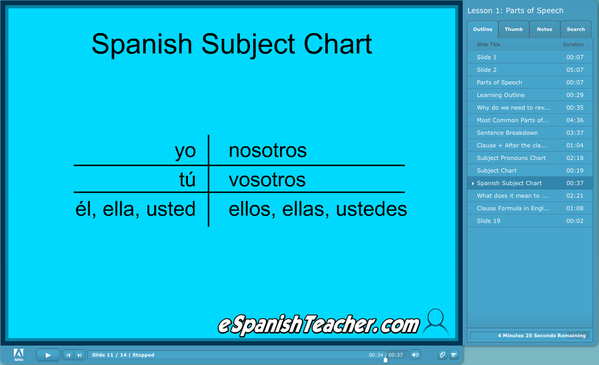
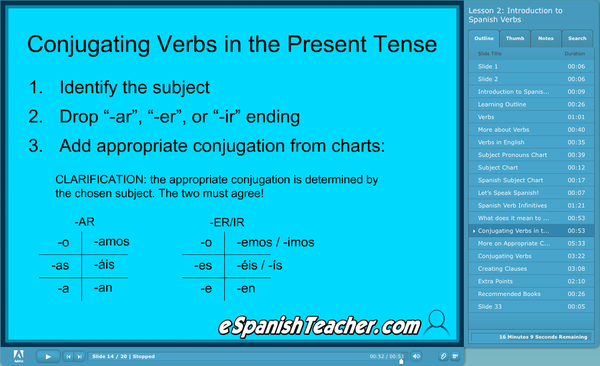
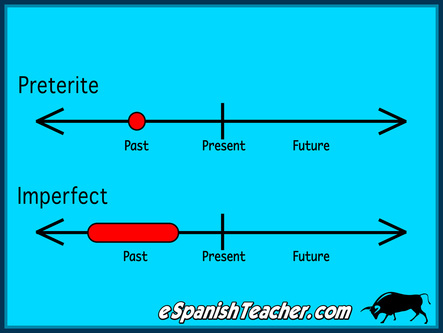
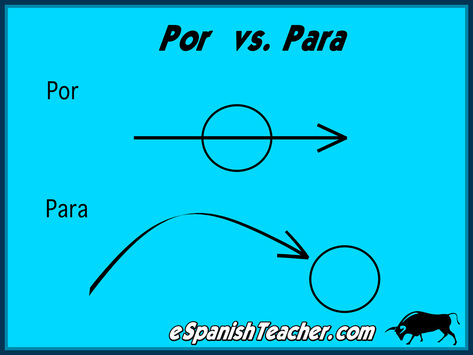
 RSS Feed
RSS Feed
